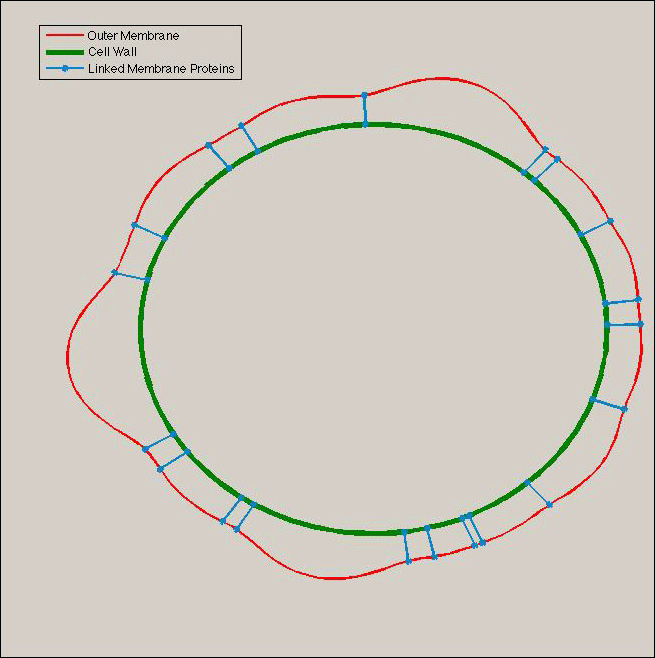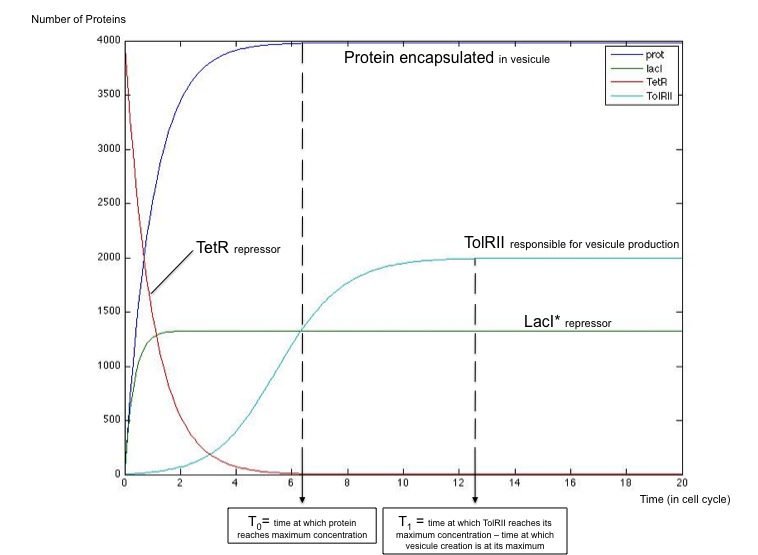Team:Paris/DryLab
From 2009.igem.org
Gregory Batt (Talk | contribs) (→Questions) |
Gregory Batt (Talk | contribs) (→Results) |
||
| Line 31: | Line 31: | ||
===Results=== | ===Results=== | ||
| + | *'''Understanding the link between Tol/Pal expression and vesicule formation''' | ||
| - | + | Overall, we showed that the '''formation of vesicles can be simply explained by the diffusion of Tol/Pal protein complexes'''. | |
| + | This very surprising result comes from 3 specific phenomena: | ||
| + | :* The initial formation of small ''blebs'' can be explained by ''differences of osmotic pressures'' between intra- and extra-cellular environments, together with a non-perfectly uniform distribution of Tol/Pal complexes acting like ''press studs''. (<u>[[Team:Paris/Production modeling2#top|Details]]</u>) | ||
| + | :* At the basis of nascent blebs, where the outer membrane is ''non-flat'', the simple diffusion (ie Brownian motion) of ''doubly-anchored'' Tol/Pal molecules leads to their accumulation. | ||
| + | :* Rings of accumulated Tol/Pal at the basis of nascent blebs tend to ''constrict'': '''vesiculation happens'''. This again simply results from plain Brownian motion on non-flat surfaces. | ||
| - | [[Image: | + | [[Image:Vesicle_wiki.jpg|400px|center]] |
| - | + | ||
<center> | <center> | ||
| - | + | figure: Initial formation of small ''blebs'' resulting from intra- and extra-cellular osmotic pressures differences combined with non-perfectly uniform distribution of Tol/Pal complexes acting like ''press studs'' between the internal membrane and the outer membrane. | |
</center> | </center> | ||
| - | |||
| - | |||
| - | + | *'''Improving the quality of the signal sent''' | |
| - | + | To create a delay between the maximum concentration of proteins and of the maximum creation of vesicules by time units, we used a transcriptional cascade inside the genetic network thus synchronising protein and vesicule creations. | |
| - | + | ||
| - | + | ||
| + | [[Image:Delay System.jpg|800px|center]] | ||
| - | + | <center> | |
| - | + | Plot showing that vesiculation happens only once the protein encapsulated has reached its maximal concentration. | |
| - | + | </center> | |
| - | + | ||
| - | + | ||
| + | *'''Optimizing the quality of message reception''' | ||
Concerning reception, stochastic simulations revealed two possible problems reducing the robustness of our reception system : | Concerning reception, stochastic simulations revealed two possible problems reducing the robustness of our reception system : | ||
Revision as of 16:57, 18 October 2009
iGEM > Paris > Home > DryLab > Main
Main
Questions
Our Message in a Bubble project aims at developing a communication system between bacterias. Among the various problems raised during the design phase, we investigated 3 of them with modeling and simulation:
- What is the link between Tol/Pal expression and vesicule formation? Or, more precisely, can we explain vesicule formation solely by the diffusion of the doubly anchored Tol/Pal complex in the membrane ? Understanding this connection is instrumental, since our project relies on the hypothesis that an increased in vesicule formation can be obtained simply by destabilization of the Tol/Pal complexes.
- How to improve the quality of the signal sent? Or more precisely, how can we get a good synchronisation between the maximal production rate of vesicules and the maximal concentration of proteins to encapsulate ?
- How to optimize the quality of the reception? Or more precisely, how can we get a robust response despite a potentially very low number of signals (ie, vesicles) recieved ?
Results
- Understanding the link between Tol/Pal expression and vesicule formation
Overall, we showed that the formation of vesicles can be simply explained by the diffusion of Tol/Pal protein complexes. This very surprising result comes from 3 specific phenomena:
- The initial formation of small blebs can be explained by differences of osmotic pressures between intra- and extra-cellular environments, together with a non-perfectly uniform distribution of Tol/Pal complexes acting like press studs. (Details)
- At the basis of nascent blebs, where the outer membrane is non-flat, the simple diffusion (ie Brownian motion) of doubly-anchored Tol/Pal molecules leads to their accumulation.
- Rings of accumulated Tol/Pal at the basis of nascent blebs tend to constrict: vesiculation happens. This again simply results from plain Brownian motion on non-flat surfaces.
figure: Initial formation of small blebs resulting from intra- and extra-cellular osmotic pressures differences combined with non-perfectly uniform distribution of Tol/Pal complexes acting like press studs between the internal membrane and the outer membrane.
- Improving the quality of the signal sent
To create a delay between the maximum concentration of proteins and of the maximum creation of vesicules by time units, we used a transcriptional cascade inside the genetic network thus synchronising protein and vesicule creations.
Plot showing that vesiculation happens only once the protein encapsulated has reached its maximal concentration.
- Optimizing the quality of message reception
Concerning reception, stochastic simulations revealed two possible problems reducing the robustness of our reception system :
- when the amount of messengers received is too weak, the activation does not always occur
- even when it occurs, the activation time can vary.
 "
"

